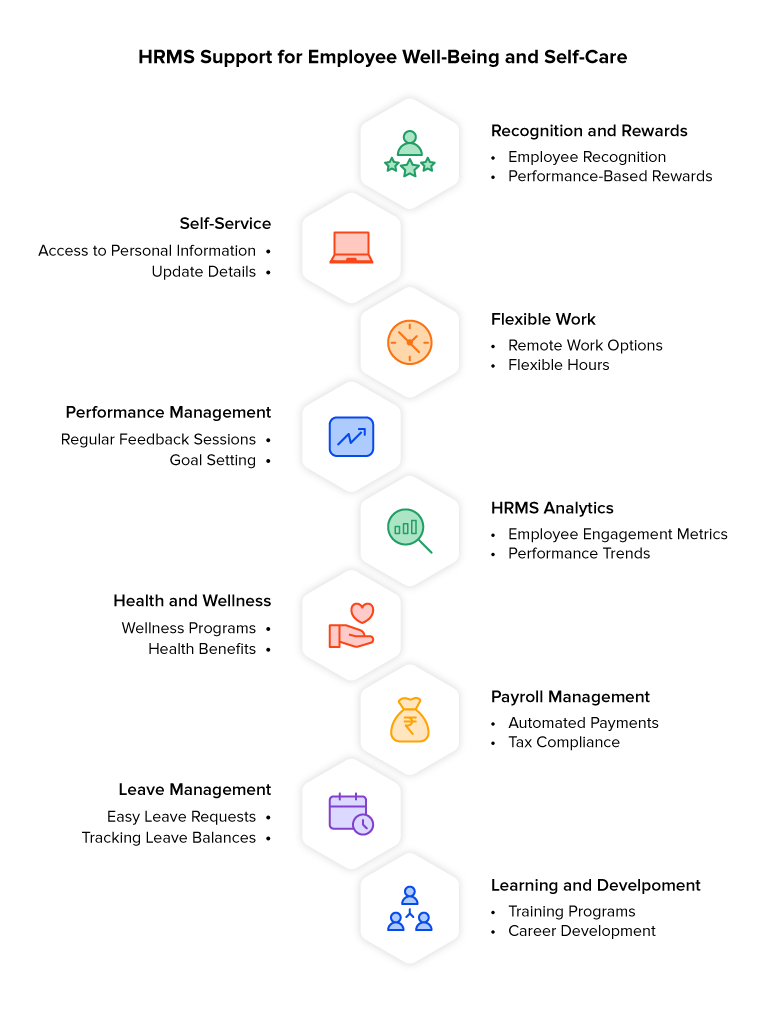How does HRMS Support Employee Well-Being? (9 Practical Ways)

Table of Contents
Employee well-being is all about keeping employees physically, mentally, and emotionally healthy at the workplace. A healthy team boosts employee performance and engagement.
Effective use of time off and a supportive atmosphere, where employees feel appreciated and their concerns are acknowledged, enhance workplace productivity. In today’s evolving business scene, prioritizing wellness is crucial. Organizations have realized that employee well-being affects individuals as well as organizations.
Previously, HRMS was primarily used as an administrative, payroll, attendance, and record maintenance system. Evolving digital technologies empower employees with various features programmed to facilitate communication, flexibility, and engagement.
This article explores nine effective ways an HRMS can positively contribute to employee well-being. HRMS can improve operational effectiveness and build a supportive, employee-oriented work culture by analyzing its various functionalities.

9 Effective Ways HRMS Supports Employee Well-Being and Self-Care

Employees with Self-Service
Employee self-service portal allows employees to access their data, such as attendance, leave details, claim reimbursements, and payslips on the portal without bothering HR.
Using a self-service portal helps avoid inconvenience for employees and employers. It’s a centralized portal, allowing employees to check out department announcements immediately. ESS allows employee engagement by providing surveys, acknowledgements, and celebrating personal milestones. An employee self-service portal creates an environment that emphasizes accountability and is rooted in trust.
Payroll Management
Prompt and precise payroll processing continues to be a crucial focus for many employees. The HRMS guarantees accurate payroll and compliance with statutory regulations. When employees start trusting their compensation management system for timely disbursement, they are relieved from facing any financial challenges.
Automating payroll activities brings transparency and accuracy by easily accessing employee earnings, tax deductions, and payroll for better insights. This helps employees manage their finances.
Leave Management
Successful leave management is one of the most important factors in the HR process that ensures employee well-being. HR tools enable remote access to automated alerts, leave applications, and approvals, allowing employees to effortlessly monitor their leave balance and arrange their time off, thus enhancing their work-life balance.
A leave management system integrated with HRMS helps with better workforce planning by allowing managers to check employee availability, approve requests, distribute work, and improve workflow. Additionally, organized leave management fosters a culture where time off is valued and normalized. As long as employees are certain that their well-being is respected and that absence from work will not adversely affect their professional status, they are more likely to be productive.
Flexible and Remote Work Arrangements
HRMS platforms make it easier to work flexibly and remotely. They provide features for tracking time, managing attendance, and collaborating online. HRMS tools help create a better work-life balance by allowing different work styles and schedules. When employees can manage their work hours, they feel relaxed and more satisfied.
Flexible arrangements include HRMS integration with communication and project management tools, simplifying remote teamwork. Remote workers can feel a supportive work culture by fostering flexible work schedules that impact their well-being.
Transparent Performance Management and Feedback
Transparency in tracking employee performance allows individuals to assess their own performance. It fosters increased confidence, heightened accountability, improved decision-making, and a stronger motivation. Such transparency also affects employee commitment and retention rates. Engaged employees tend to be more productive and loyal to their organizations, resulting in reduced turnover rates.
Additionally, HRMS platforms provide continuous feedback. This creates a supportive work environment that prioritizes employee well-being. Monitoring employee performance plays a part in an employee’s long-term mental well-being.
Promoting Learning and Development
Learning and development are the basics for employee growth and career advancement, ultimately benefiting individuals and the organization. HRMS integrating with learning management enables structured employee training programs and upskilling opportunities.
HRMS platforms provide personalized learning paths based on employees’ roles, interests, and performance evaluations. By facilitating continuous improvement, organizations foster confidence, engagement, and long-term satisfaction among their workforce.
Recognition and Rewards
The recognition tools in an HRMS allow employees’ efforts to be systematically acknowledged. Recognizing an employee’s contributions promptly and fairly enhances engagement and performance. Acknowledging an employee’s preferences for financial and experiential rewards demonstrates that their contributions are valued and appreciated.
The digitization of HR processes has made the rewarding process less complicated. Features like bonuses, employee achievement tracking, and public appreciation are all included in HRMS. Recognition and rewards motivate employees, which boosts their morale and enhances their productivity.
Health and Wellness Program
Encouraging employee well-being is a beneficial strategy for boosting employee morale and improving workplace performance. Such programs include health checkups, fitness challenges, therapy, etc., to increase an employee’s overall health. By integrating this employee wellness program with the HRMS, organizations can promote a culture of active health maintenance.
An HRMS facilitates easy management and monitoring of wellness programs. By monitoring program participation, employee feedback, and health outcomes, organizations can assess the impact of their initiatives and make data-driven decisions. In addition, health and wellness initiatives send a clear message that an organization is seriously invested in the well-being of its employees.
When employees know that their well-being matters, it strengthens their sense of belonging and trust within the organization. This enhances morale and decreases stress, improves productivity, reduces absenteeism, and improves organizational culture.
Use HRMS Analytics
HRMS analytics are essential for gaining insights into employees’ behaviours, performance, and engagement levels. Using data on absenteeism, turnover, performance, and participation in wellness programs, organizations can proactively spot patterns suggesting underlying issues in the overall well-being of the employees. Advanced analytics also supports the customization of well-being initiatives. HRMS analytics fosters accountability and continuous improvement.
To effectively enhance employee well-being through automation and streamlined processes, it’s crucial to understand how HR software works. This complete guide to HR software explains the key features, benefits, and how the right system can support both HR teams and employees alike.

Conclusion
HR can significantly impact an organization by focusing on employee well-being and creating a supportive work environment. Integrating HRMS-driven wellness into an organization improves mental health, promotes greater job satisfaction, and encourages a healthy work-life balance, essential for long-term organizational success.
In today’s world, many HRMS solutions are available; factoHR stands out with its extensive approach to employees’ welfare. factoHR’s Modern HRMS is essential for supporting employee wellness and enabling self-care..
What is the Role of HR in Employee Well-Being?
The Human Resources (HR) department plays a pivotal role in ensuring employee well-being through the planning, execution, and administration of policies. These involve creating a positive work environment, access to wellness resources, fair work practices, feedback, and support. HR can integrate well-being into the organizational culture to create a better workplace for employees.
How to Improve Employee Well-Being?
Enhancing employee well-being requires a comprehensive strategy that encourages open communication, offers flexible work schedules, and grants access to wellness and mental health resources. Organizations should also appreciate and provide ongoing learning opportunities and create a friendly and inclusive workplace culture.
What is Employee Wellness in HRM?
Employee wellness in HRM means integrating programs that improve workers’ general health, safety, and quality of life. By making wellness an integral HR function, organizations reduce absenteeism, save healthcare expenses, and increase employee engagement, satisfaction, and retention, eventually leading to better organizational performance.
Grow your business with factoHR today
Focus on the significant decision-making tasks, transfer all your common repetitive HR tasks to factoHR and see the things falling into their place.

© 2025 Copyright factoHR


